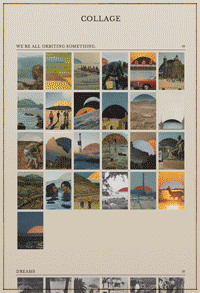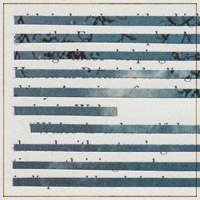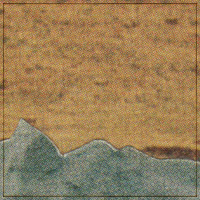Victoria Masters: Music Felt Through the Lens

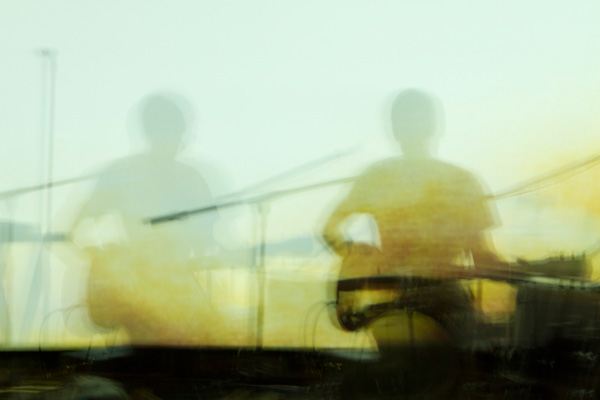


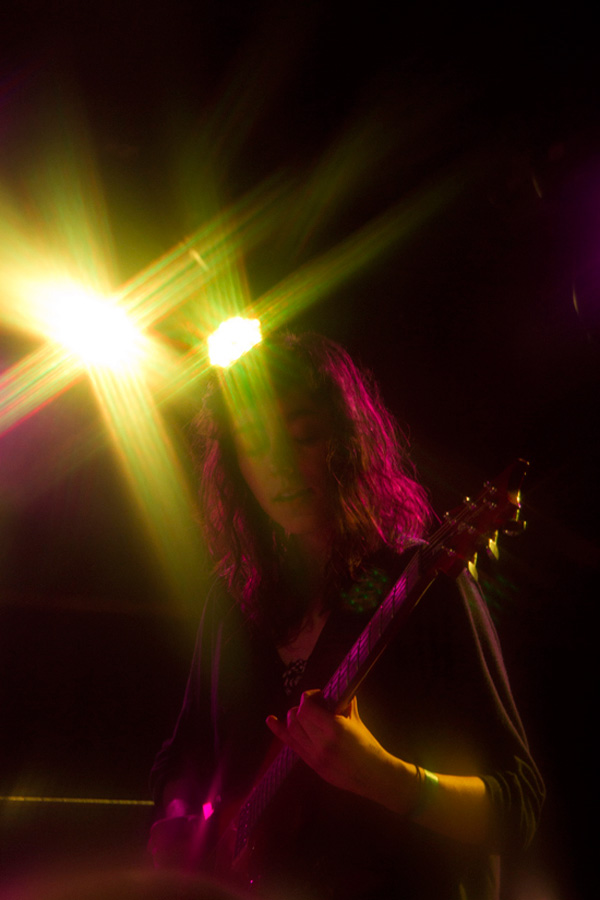









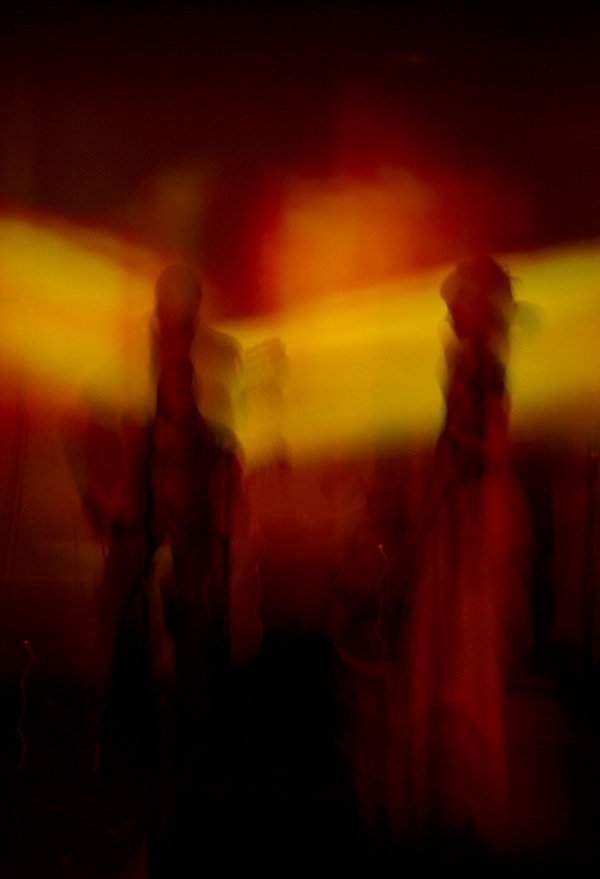


I believe in a soul; not necessarily in a religious context, but certainly in a spiritual one. Places hold them —people, ideas, events. I believe experiences enter their purest state when souls are communicating, and this happens often within art. Musicians understand this shared energy. And with live performance, they hope to inspire it. There are shows when a room can collectively glow or charge or even gravitate. These are beautiful yet fleeting occurrences, and rarely ever documented truly. But some have a gift…
Through photography, Victoria Masters is able to send you to that suspended realm, whether you were once there before or not. I’d admired her work for some time, as she’s one half of the music blog Stadiums and Shrines, but it wasn’t until I stood next to her at a Julianna Barwick set during SXSW that I fully understood. Looking over at the tiny screen on her camera after each shot, I realized she was capturing not what was in front of us at face value, but the images of our perception. Each time I return to one of her pictures, I don’t simply see a night, I feel it.
The images that opened this piece were selected to represent 2011; in other words S&S has decided to host their annual Year in Photos here, and even more kindly, Victoria was down to chat about her craft, process, and future plans.
Can you tell us a little about your photographic background and how you started shooting shows?
It started with a photojournalism class I took in college. I went to Senegal for a summer abroad program where we documented current events in and around Dakar. It was instantly so inspiring. I was taken in by all the colors and skin tones, and the way the French African culture juxtaposed with poverty. I went on to major in graphic design but never really stopped studying photography. After school I took six months to travel Southeast Asia and shoot. Upon return I participated in some small gallery shows and an international touring exhibit about children living in poverty. When I moved to New York six years ago, I began more classes at the International Center of Photography in Manhattan and have kept taking them since. Somewhere between then and now that background blended with my love for music and living in Brooklyn, and I started shooting shows. Then when S&S entered my life there was good reason to continue.
When I learned that you don’t use Photoshop to alter your images I was utterly amazed, still am. Without giving away any secrets, can you share some of your process?
Yeah there was some concern that people were going to think these were just altered in post which felt untrue to my process. Similar to photojournalism, there’s a story to be told, an emotional connection between subject and audience, we all want to feel that intensity and beauty, and it’s your responsibility to capture it evoking as much emotion and realness as possible. So, well, yea that’s what I try to do—I use some slow shutters, flash delays, and soften edges to get the vision all better realized. I work a lot with the lighting of a space, you really need to adapt to it to feel comfortable.
You’ve developed a very distinct and effective visual language. How do you prepare for a night of shooting and how much of the outcome is a result of simply being in the moment?
I usually bring a bag that has my Canon 7D, a few lenses, vaseline, red lipstick and my hotshoe flash. And I’m usually groaning about how I dont want to be out until 2am on a Tuesday, but once I get there my mood just flips. I start to feel what’s happening and it all just comes together… eventually. Certain venues, crowds, and lighting can really determine how challenging a shoot it will be. I can get frustrated at times and that’s when I just try something totally different, and then pass my screen over to Dave for the smile of approval (I have a scale of reactions to rate from) and carry on.
Do you have any favorite bands to photograph? Any particular qualities you’re inspired by?
Shooting Handsome Furs was my highlight of the year but I think my favorite band to photograph is Twin Sister. We’ve covered them a number of times and I’m always taken by Andrea’s presence, and their lighting is always rad. Second would be Born Gold, for obvious reasons. I like the energetic bands. It can get more tricky when shooting some of these one-person electronic acts, where there isn’t much going on, that’s when I really try to translate more of a sound or mood.
Lastly, what do you see yourself working on in the future? Are you exploring any new avenues your work could travel down?
Seems I am never not starting a new project. There’s this ongoing Portraits project that includes shooting friends in their environments, and I’ll be doing more band press photos this winter. I rarely pass up opportunities, I’m addicted to this whole lifestyle. I’ve also been experimenting in film this year—I shot/edited a live visual projection for a 45 minutes dance performance and a few months back did a music video feature on our roof. We’ll see where video goes…
Thank you Victoria.
Bands pictured from top down: Dirty Beaches, Two Bicycles, Grimes, Big Troubles, Braids, Born Gold, Julian Lynch, Megafortress, RxRy, Pictureplane, Born Gold, Dustin Wong, Handsome Furs, Blue Hawaii, Holy Spirits, WU LYF, Julianna Barwick.

Think or Smile Holiday Giveaway


Blogging is a bizarre activity. Passions are translated to code then buried on a digital mountain side, hoping someone will find them. At times it’s easy to feel disconnected from reality while sitting behind this computer screen, yet that is what’s celebrated here: reality, art, life. Without you—readers, artists, collaborators, friends—Think or Smile wouldn’t be. That said, I’d like to take this opportunity to show my continued appreciation for both your inspiration and support by bringing back the (now annual) holiday giveaway.
To my surprise, quite the package has come together over the course of just one day, which is a true testament to the generosity of this community. Existing primarily virtually, I think its important to remember that a lot of what I share here and love are physical objects, so included in the giveaway are some of my favorite releases, donated and signed by good friends, along with a New Directions book that traveled with me for a good part of the year, inspiring my own art, which I’ll also include an original of.
Here’s the treasure chest one winner will find at their doorstep: A signed copy of Gem Club’s “Breakers” on vinyl, an out-of-print 12″ of Monster Rally’s “Coral,” signed along with an original drawing of his. The Holy Spirits/Mutual Benefit split “Mutual Spirits” on vinyl, the Mutual Benefit/Philip Seymour Hoffman split on cassette and a signed copy of Teen Daze “A Silent Planet” on CD. I asked RxRy to include an album, instead Rx went into the lab and made an entire mix of (partially unreleased) sounds – “a.GFT” one-of-a-kind CDr in handmade packaging. It’s an Rx original art piece and will be yours alone to space to. New Directions Publishing has been kind enough to donate a copy of Eliot Weinberger’s “An Elemental Thing,” a favorite book on mine this past year. I’ll also hand make a new Thought Orb collage for you.
How to enter: Simply share a comment below. What on the site did you enjoy most this year, or what would you like to see more of next year? Or just say hello. I like hearing from you.
Please, only one entry per person. It will end on 12/25/2011 at midnight EST. I’ll randomly select one winner and notify by email in the days following.
Much love.
UPDATE 12-26-2011: …And the randomly selected winner is Peter A. Thanks to everyone for entering! Here’s to another wonderful year.

Musical Eyes: Pressed And on Street Art and Fauvism



Traversing space in reverse, blinking in slow motion while moving at warped speed… the imagined side effects of Pressed And are infinite. The music that Mat Jones and Andrew Hamlet make together has a way of picking you up from your seat and propelling you forward without relent—it’s a textural journey like no other. And the experience doesn’t simply stop at sound; they had their debut EP Imbue Up developed into a loose film which recently premiered at the Ackland Art Museum Film Forum and online at Stadiums & Shrines.
One doesn’t come to create sonic textures like Pressed And working in isolation, so I’ve asked them to share with us some of their visual inspirations. The responses on paper seem incongruent, Mat’s lean toward graffiti and Andrew’s favor Fauvism, but when viewed side by side the 100 year gap is quickly closed.
You each have solo projects of your own, Mat as It is rain in my face. and Andrew as ArnHao. Can you tell us how your collaboration became Pressed And and what each of your contributions are to the sound?
AH: ArnHao is my collaboration with Arturo “Trizz” Holmes II; we are on hiatus but have unreleased material that we’d both like to eventually make public.
As for solo material, I make ambient guitar and soundscape pieces. ”Pinnacle Cow” more or less represents the sound of my solo material. I recorded that song after hiking along the Appalachian Trail where I encountered cattle standing in a meadow that overlooked a beautiful expanse of the Blue Ridge Mountains.
Mat and I met through a mutual friend, Tripp Gobble (who would later go on to co-found Denmark Records). Tripp and I ran UNC’s student-run record label Vinyl Records, and Mat performed in one of our annual showcases and recorded an EP for our monthly VR Presents series.
About a year after first meeting, ArnHao was scheduled to perform at a Denmark Records showcase but ended up having to cancel. Tripp asked Mat, as It is rain in my face., to substitute for ArnHao. Mat and I chatted after his performance and decided to start working on material together. About two months later we had our first song, “Etching,” which is featured on Imbue Up.
MJ: We don’t really have set roles in constructing the songs. If either of us come up with something interesting, no matter what it is, then we keep it. Generally, I do most of the vocal samples and Andrew does most of the ambience.
Mat, in addition to being a musician you also work as a visual artist, utilizing basic elements of form and color to create compositions you describe as purely aesthetic. How interwoven is your visual art with your music? Do they build upon the same core concepts?
MJ: I think music and art come from the same place for sure. When I make stuff I typically concentrate on the technical aspect of it, no matter what it is I’m making. It’s only at the end that I can look back and figure out what anything means.
Both your and Oliver Vernon’s paintings have underlying elements that seem to derive from street art. What about graffiti are you drawn to? What other artists/types of art do you look to for inspiration?
MJ: I really enjoy the idea of someone painting on a wall that doesn’t belong to them. Even though it has it’s negatives (like you just ruined someone else’s property and somebody’s going to have to clean up after you) I think it’s a beautiful representation of something essentially human. Folks have been painting on walls for thousands of years and it’s cool that we still find it significant. I guess most of the artists I like are associated with street art and graffiti, because with that type of art there’s such an emphasis on interesting colors and compositions. That’s what I primarily enjoy about Oliver Vernon and Augustine Kofie…and Escif as well, though his colors and composition are interesting in a more subtle way. Escif is also very clever and funny, which is something everybody loves.
Rich saturated color and an emphasis on the inherent qualities of painting–brush stroke, the build up of pigment, etc., were a main focus of Derian and Matisse during their Fauvist years. Andrew, can you speak to the aesthetic parallels of how you approach sound as an art medium and the art you enjoy?
AH: Whereas extreme displays of color characterized the Fauvist aesthetic, sonic texture and richness of harmony inform my approach to sound. Right around the time I first started to understand the guitar, I took an interest in jazz. It is funny because jazz players describe variations in harmony as “color,” and this is most definitely where I developed my sense for complex chords and voicings.
But unlike jazz and its improvisation, my contributions are simple and refined–like the Fauvists. I believe “color” can be enough to imbue a piece with a certain emotion.
With your recent ep, Imbue Up, you had each track visualized by different video artists and provided no direction as to how it should look. How important is it for Pressed And to have visual art accompany the music and why was it decided to not direct the artists?
MJ: I feel like having something visual just makes it that much more of an experience for people to take in. I’ve always thought that music and art are about connecting with other people, so I’d guess we’d like to achieve that through whatever means possible. As to not directing the videographers, I think it just went along with the music…when Andrew and I make music we don’t try to direct anything a certain way, we just feel around in the dark until we find something that’s satisfying. I feel like if you’re not imposing some kind of direction on what you’re making then you’re able to find something more genuine, which is hopefully what got reflected in the videos that everyone made.
AH: There was a trust that the music would direct the video artists to whatever it was that would inspire them to create. In that way, it was more of an experiment in how the artists would perceive their respective songs and how their perceptions would collectively come together to form a whole. I am really impressed with some of the themes that emerged as a result. It appears the video artists picked up on water, outer space, and sexual energy, among others. Additionally, by not directing the video artists, we, in effect, allowed the creation of the movie to become a performative art. I think the work ended in a beautiful statement on our current collective sense of human agency, or lack thereof. For myself as I imagine for many others lately, I have felt very much out of control of the many variables in my life, but as the creation of Imbue Up suggests, perhaps there is an underlying order to this chaos.
Thank you Mat. Thank you Andrew.
Their debut EP Imbue Up, is out now on Crash Symbols. You can stream/purchase the limited edition cassette here.
Images from top down.
- Oliver Vernon: Spitfire – 2009
- Oliver Vernon: Crossfire #3 – 2008
- Oliver Vernon: Promised Land – 2007
- Mat Jones: Okay With It - 2011
- Mat Jones: This Is How I Will Speak To You - 2011
- André Derain: Charing Cross Bridge – 1905
- Henri Matisse: La Moulade – 1905
- André Derain: Paysage à L’Estaque – 1906
- Henri Matisse: La Moulade (Collioure in the Summer) – 1905

Free Music Collection: December 2011

Gifts worth giving are often intangible, even unspoken. They’re felt—sensorial moments; sights, scents, and sounds. They’re cherished because they bring happiness, or clarity or solace; they can lift, reawaken or recast a light from the past. They become who we are. True gifts, both given and received.
We hope you will find new sounds, new joys within ours.
Free Music Collection: December 2011
- Giraffage – Comfort: Finely crafted beats overlaid with a blanket of lush ambiance, as comforting as a warm blanket in winter.
- Egyptian Maraccas – This Is So Random: A massive mixtape of our favorite producers, making new things out of old, making us feel hot and steamy.
- It is rain in my face. – TAWS: Speaker Snacks Records keeping its untainted record going with this eclectic album from Brooklyn producer Matthew Jones.
- Glass Vaults – Into Clear EP: Soundscapes to set the stage for your mental escapades, through cerebral valleys, over metaphysical mountains capes.
- Hollow Pigeons – Birthdays: Birthdays flows soft and lightly from start to finish, bringing us what can only be an impressive start to a hopefully long life of blissful production.
- Symmetry – LYFSTYL 006 Mixtape: Compiled from some of my favorite bloggers, a mixtape to get you in the mood for a cooler season.
- Invisible Children 2011 Benefit Show Mixtape: My homies over at IC put together a mix for their benefit show, if you’re in the LA area this Christmas, you need to hit this up. This year features The Mountain Goats, Fruit Bats, Ivan and Alyosha and more.
- Head Underwater Whitehurst Frwy Mixtape: You can always count on Jimmy for a good mood-mix.
- Caribou’s ATP Mix “Nightmare Before Christmas”: If you can’t make it to the Nightmare Before Christmas ATP Music Fest, you can grab Caribou’s mixtape of it and pretend you’re there. That’s what I do in lieu of you know, actually going to shows.
- YOUNG ATHLETES LEAGUE – NTMIX002: I felt cooler after listening to this. Have you checked out Neighborhood Tapes yet?
- David Lynch & ‘Big’ Dean Hurley Mixtape: So David Lynch made a mix for The Stool Pigeon. That’s crazy, right? (Stream only)
- MFR – HOTT Mix: You can always rely on MFR for bold helvetica posters and mixtapes that have all the hits. This one makes me forget November’s already passed us by. (Stream only)

Think or Smile
- Korallreven – ‘Ra Ra Rave On’ Mixtape: Swedish sun-strokers dig into their 90s techno 12″ crates and drop the needle on FSOL for Self-Titled Magazine.
- Maayan Nidam live at Lessizmore: house music. love music.
- Dreampeter – Mason Jar (single): Ann Arbor experimenters combine to elevate the dream world.
- RxRy – SLPR (suite): this is for the night. and the attentive: only first 50 emails to RxRy receive download.
- Arae – The Longest Night: “a journey through introspective beatscapes and finely-tuned vocal samples.” – Flashlight Tag
- Low Light Mixes – drowsy: a sonic cocktail of Percocet & Vicodin.
- Ambassador Engine – Subtraction, Elation, Hydration.: guitar-scapes traversing moments of natural clarity and far off lands of distorted skies.
- Headaches – I Wasn’t Born Yesterday EP: theme and variation. ambience and rediscovered textural loops within.
- M. Sage – Music for Interior Shadows: Colorado’s Matthew Sage dove into a stack of old records with the idea of finding minimal chunks of sound and turning them into absent compositions. What resulted is a pure and tragic, era-bending experience. Those dark corners that sharpen each hall, the cold mirror still cued with a makeup box at its feet, the dust covered gramophone, and the lamp who’s bulb has since long passed; she’s air-waltzed away forever…
- Bad Passion – Doin’ It Slow: Extra cool, minty fresh boy/girl dialogue on a floor-level mattress. No lights, probably candles, definitely a little weed; they plot of stealing cars and covering Beach House.
- Foxes in Fiction – Guest Mix for Diamond Atlas: The angel Warren crafted a beautifully eclectic 30 minute reflection of his favorite headspaces and healing music, accompanied by personal and well-considered thought pieces for each song. He goes Azeda Booth into Arthur Russell, and my heart warms.
- Ricky Eat Acid – seeing little ghosts everywhere: There’s a whole world inside here. Like a toy world, with toy pianos, and little toy ghosts flying around, everywhere, under the 8-bit stars. It feels like ones we knew as kids and then somehow forgot. But Sam Ray didn’t, thank you Sam.
- Unravel – I Knew This Would Happen: Some brass wind chimes begin to dance, a harp joins in. A giant hand tweaks from above, like club remixing the whole sequence. Then a robot on a hilltop recites the first verse of Kayne’s “Love Lockdown”… maybe this Unravel person did, but I certainly did not, *know this would happen*.
- Casual Ocean – Goodbye Money: Lester Brown is back, as Casual Ocean, suddenly a soothing, twisted tenor on an R&B kick.
- Vinyl Williams – Lemniscate: Had we known about this pysch summit back at its August release date, we could have been climbing in tie-dye tank tops and saluting the sun with pixie dust. Actually, there are no seasons in space, so we’re good.
Support music you love. See shows, buy physical releases, show love.
Note: Due to bandcamp’s terms of service artists are required to charge a minimal price after a certain number of free downloads. If that’s the case after our posting you can always stream it and if it moves you, support them with a purchase.

Think or Smile | Nathaniel Whitcomb © 2011













